 |


 |
The Solution to Hard-To-Transfect Cells |
Delivery of nucleic acids into mammalian cells has been critical in the area of cell and molecular biology. Stem cells and primary cells have traditionally proven to be very difficult to transfect. GeneIn™ is a novel cationic transfection reagent that was developed by the inventors of the Lipofectamine 2000. GeneIn™ Reagents are a formulation of proprietary compounds that are chemically defined and are of animal-free origin. Tested on a wide range of cell lines, GeneIn™ requires minimal optimization to achieve superior expression results.
|
Features |
- High transfection efficiency in hard to transfect cells
- Optimal transfection efficiency and low cytotoxicity
- Validated on multiple cell lines
- Robust and reproducible performance
- Fast and easy-to-follow Quick Optimization Protocol
|
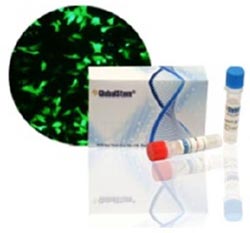 |
| Catalog Number |
Product Description |
Size |
|
| GST-1000 |
GeneIn™ Transfection Reagent -0.25ml (Sample Size) |
0.25 ml |
| GST-1001 |
GeneIn™ Transfection Reagent -0.75ml |
0.75 ml |
| GST-1002 |
GeneIn™ Transfection Reagent -1.5 ml |
1.5 ml |
| GST-1003 |
GeneIn™ Transfection Reagent -5 x 1.5ml (Value Pack) |
5 x 1.5 ml |
|
| |
Maximum Delivery into Primary Cells and Stem Cells |
GeneIn™ has been optimized for intracellular gene delivery into difficult to transfect mammalian cells. Comparative studies against the leading competitors’ reagents show GeneIn™ to be superior in transfection efficiency with minimal cytotoxicity.
|
|
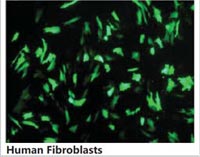 |
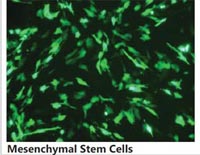 |
Images show high levels of GFP expression with low cytotoxicity in a wide range of cell types at 24 or 48 hours when using the recommended amounts of GeneIn™. |
|
| |
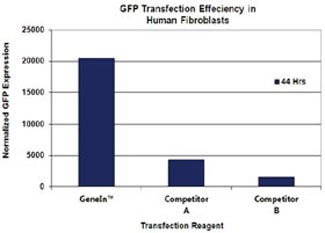 |
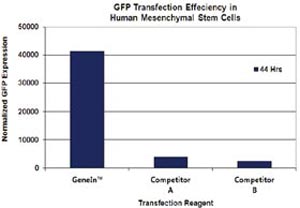 |
Figures 1 & 2 - Significantly higher transfection efficiency over leading competitor reagents. Using GeneIn™, human fibroblasts and mesenchymal stem cells were transfected with GFP plasmid. After 44 hours, results show much higher transfection efficiency with GeneIn™ than the leading competitors’ reagents.
|
Robust Performance |
 |
| |
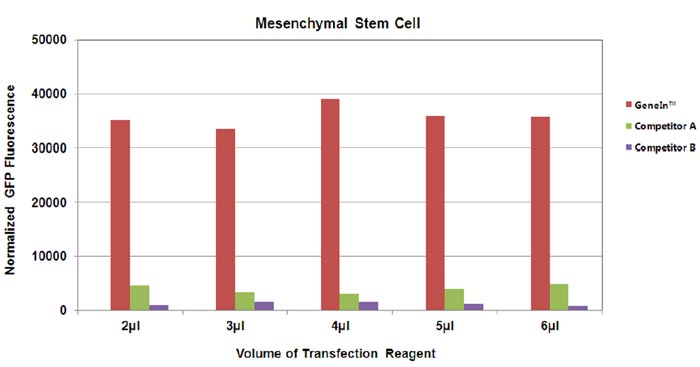 |
| |
Figures 3 & 4 - Excellent Dynamic Range - Human Fibroblasts (top graph) and Human Mesenchymal Stem Cells (bottom graph) were transfected with GFP plasmid. The above data show performance across a range of reagent volumes after 24 hours. In each case, the manufacturer’s recommended DNA concentration was used.
|
Outperforms Leading Competitors’ Reagents |
|
| |
GeneIn™ |
Competitor A |
Competitor B |
| Human ES |
 |
 |
 |
| Umbilical Mesenchymal Stem Cells |
 |
 |
 |
| Human Newborn Fibroblast |
 |
 |
 |
| CH0 |
 |
 |
 |
| NIH 3T3 |
 |
 |
 |
|
| |
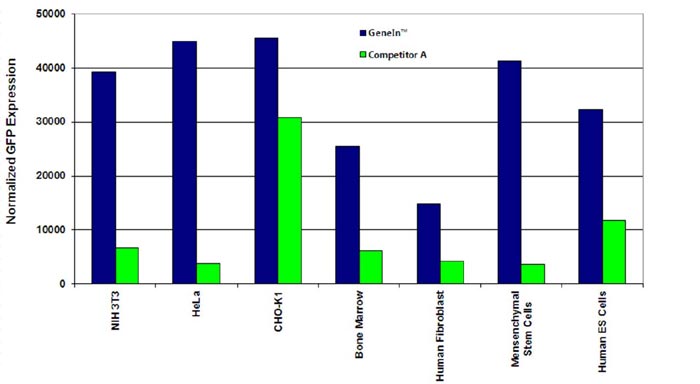 |
| |
Figure 5 - High GFP expression in a broad range of cell lines. Hard-to-transfect primary cells and stem cells exhibit high transfection expression of GFP using GeneIn™. The above chart shows GFP expression after 24 or 48 hours. GeneIn™ significantly outperformed the leading competitor reagent in each cell type.
|
Validated across a range of commonly used cell lines |
|
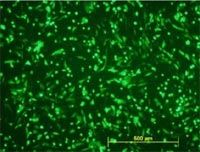
CHO |
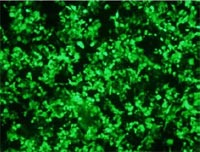
HEK-293 |
Images show high levels of GFP expression with low cytotoxicity in a wide range of cell types at 24 or 48 hours when using the recommended amounts of GeneIn™. |
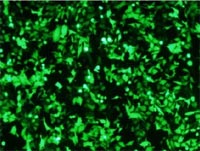
Hela |
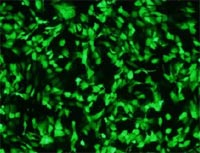
NIH 3T3 |
|
|
| |
Specifications |
|
| Cell Types |
Hard-to-Transfect Cells
Primary Cells
Stem Cells
Commonly used cell lines |
| Product Size |
0.25ml
0.75ml
1.5 ml
5 x 1.5ml
Bulk (upon request) |
| Classification |
Animal-free |
| Serum Compatible |
Yes |
| Sample Type |
DNA Plasmid |
| Storage |
Store at 4°C, Do not freeze |
| Use Restrictions |
Research Use Only
See also Limited License Agreement |
|
| |

